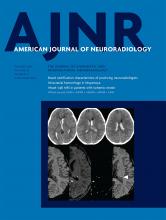Index by author
Jaigobin, C.
- EDITOR'S CHOICEAdult BrainYou have accessDiagnostic Impact of Intracranial Vessel Wall MRI in 205 Patients with Ischemic Stroke or TIAJ.D. Schaafsma, S. Rawal, J.M. Coutinho, J. Rasheedi, D.J. Mikulis, C. Jaigobin, F.L. Silver and D.M. MandellAmerican Journal of Neuroradiology October 2019, 40 (10) 1701-1706; DOI: https://doi.org/10.3174/ajnr.A6202
This was a single-center, retrospective study of 205 consecutive patients who were referred for vessel wall MR imaging to clarify the etiology of an ischemic stroke or TIA. An expert panel classified stroke etiology before and after incorporating vessel wall MR imaging results using a modified Trial of Org 10172 in Acute Stroke Treatment system. Vessel wall MR imaging altered the etiologic classification in 55% (112/205) of patients. The proportion of patients classified as having intracranial arteriopathy not otherwise specified decreased from 31% to 4% (64/205 versus 9/205) and the proportion classified as having intracranial atherosclerotic disease increased from 23% to 57%. When vessel wall MR imaging is performed to clarify the etiology of a stroke or TIA, it frequently alters the etiologic classification, which is the basis for therapeutic decision-making.
Ji, X.
- FELLOWS' JOURNAL CLUBAdult BrainOpen AccessCerebral Venous Thrombosis: MR Black-Blood Thrombus Imaging with Enhanced Blood Signal SuppressionG. Wang, X. Yang, J. Duan, N. Zhang, M.M. Maya, Y. Xie, X. Bi, X. Ji, D. Li, Q. Yang and Z. FanAmerican Journal of Neuroradiology October 2019, 40 (10) 1725-1730; DOI: https://doi.org/10.3174/ajnr.A6212
Twenty-six participants underwent conventional imaging methods followed by 2 randomized black-blood thrombus imaging scans, with a preoptimized DANTE preparation switched on and off, respectively. The signal intensity of residual blood, thrombus, brain parenchyma, normal lumen, and noise on black-blood thrombus images were measured. The thrombus volume, SNR of residual blood, and contrast-to-noise ratio for residual blood versus normal lumen, thrombus versus residual blood, and brain parenchyma versus normal lumen were compared between the 2 black-blood thrombus imaging techniques. The new black-blood thrombus imaging technique provided higher thrombus-to-residual blood contrast-to-noise ratio, significantly lower thrombus volume, and substantially improved diagnostic specificity and agreement with conventional imaging methods.
Jiang, W.-J.
- EDITOR'S CHOICENeurointerventionOpen AccessSafety and Efficacy of Transvenous Embolization of Ruptured Brain Arteriovenous Malformations as a Last Resort: A Prospective Single-Arm StudyY. He, Y. Ding, W. Bai, T. Li, F.K. Hui, W.-J. Jiang and J. XueAmerican Journal of Neuroradiology October 2019, 40 (10) 1744-1751; DOI: https://doi.org/10.3174/ajnr.A6197
Twenty-one consecutive patients with ruptured brain AVMs who underwent transvenous embolization were prospectively followed between November 2016 and November 2018. Complete AVM nidus obliteration was shown in 16 (84%) of 19 patients. One (5%) patient with a small residual nidus after treatment showed complete obliteration at 13-month follow-up. There were 5 hemorrhages and 1 infarction; 4 patients' symptoms improved gradually. Transvenous embolization can be performed only in highly selected hemorrhagic brain AVMs with high complete obliteration rates, but it should not be considered as a first-line treatment.
Jianu, D.C.
- Adult BrainYou have accessMultinodular and Vacuolating Posterior Fossa Lesions of Unknown SignificanceA. Lecler, J. Bailleux, B. Carsin, H. Adle-Biassette, S. Baloglu, C. Bogey, F. Bonneville, E. Calvier, P.-O. Comby, J.-P. Cottier, F. Cotton, R. Deschamps, C. Diard-Detoeuf, F. Ducray, L. Duron, C. Drissi, M. Elmaleh, J. Farras, J.A. Garcia, E. Gerardin, S. Grand, D.C. Jianu, S. Kremer, N. Magne, M. Mejdoubi, A. Moulignier, M. Ollivier, S. Nagi, M. Rodallec, J.-C. Sadik, N. Shor, T. Tourdias, C. Vandendries, V. Broquet and J. Savatovsky for the ENIGMA Investigation Group (EuropeaN Interdisciplinary Group for MVNT Analysis)American Journal of Neuroradiology October 2019, 40 (10) 1689-1694; DOI: https://doi.org/10.3174/ajnr.A6223








